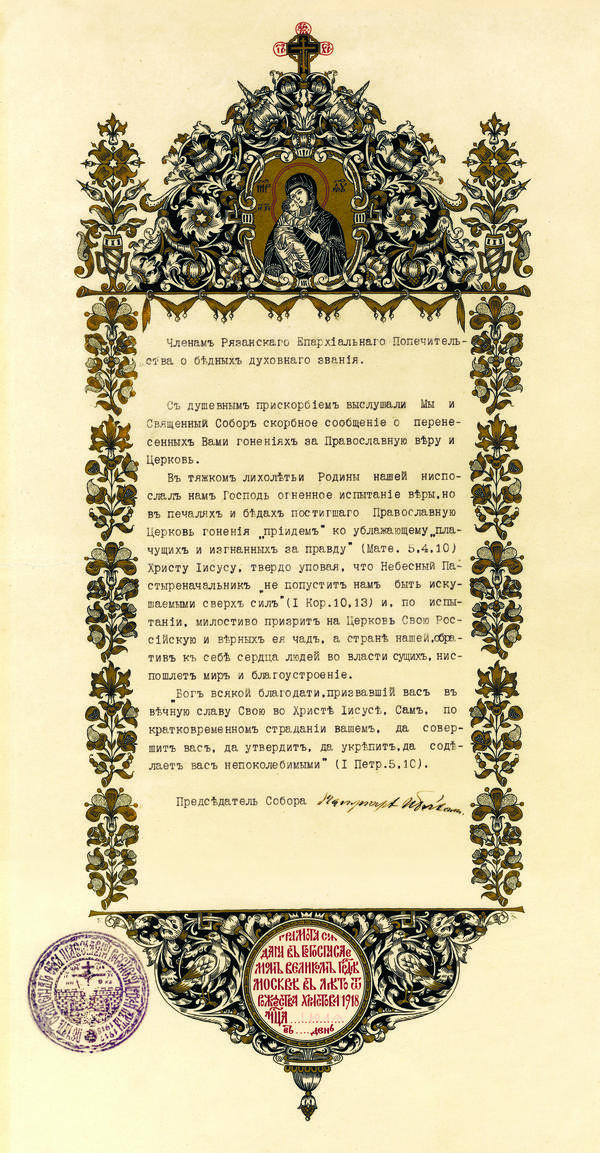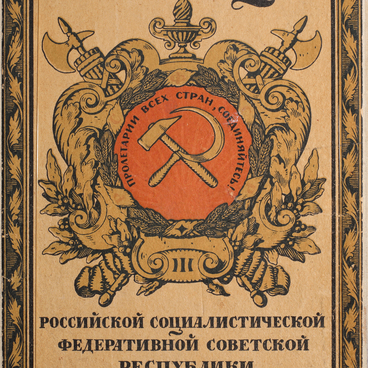In October 1917 immediately after the October Revolution church reforms started. Two centuries after its cancellation by Peter the Great, the Patriarchy in the Russian Church was restored. Having opened, Local Council of the Orthodox Church of Russia decided to restore higher church management and elected the new Patriarch after voting and drawing of lots. Metropolitan Tikhon became the new Patriarch of Moscow and All Russia.
He was a prominent church figure at the turn of the 19th and 20th centuries. In 1989, he was appointed Bishop of the Aleutian Islands and Alaska. Under his episcopacy many orthodox churches, schools and orphanages appeared in America, and following his initiatives, many clerical texts were translated into English.
In 1918, the church was officially separated from the state and clergymen started to suffer massive repressions. Besides, local authorities tried to illegally replace many diocese hierarchs with more loyal ones and interfered with their activities.
The clergymen of the diocese of Ryazan, one of the largest dioceses in Russia in the 19th-20th centuries, were heavily persecuted. Its numerous churches and monasteries were not only centers of spiritual life and education in Ryazan but also place where poor and suffering people could receive help.
In 1918, the Convention of the diocese of Ryazan ended in tragedy. Soldiers of the Red Army started to fire at the audience and arrested several clergymen. Having known about it, Patriarch Tikhon addressed the members of the Guardianship of the diocese of Ryazan with the message presented in the exposition of the museum.
‘In the troubled years our Motherland faced God sent us ordeals to test out faith, however through calamities and misfortunes that fell on the Orthodox Church we will come to Christ who comforts whose who are in despair and suffering for the truth, ” Patriarch Tikhon wrote. “And the God of all grace, who called you unto his eternal glory in Christ, after that ye have suffered a little while, shall himself perfect, establish, strengthen you. (Peter”s first message 5:10)’.
He was a prominent church figure at the turn of the 19th and 20th centuries. In 1989, he was appointed Bishop of the Aleutian Islands and Alaska. Under his episcopacy many orthodox churches, schools and orphanages appeared in America, and following his initiatives, many clerical texts were translated into English.
In 1918, the church was officially separated from the state and clergymen started to suffer massive repressions. Besides, local authorities tried to illegally replace many diocese hierarchs with more loyal ones and interfered with their activities.
The clergymen of the diocese of Ryazan, one of the largest dioceses in Russia in the 19th-20th centuries, were heavily persecuted. Its numerous churches and monasteries were not only centers of spiritual life and education in Ryazan but also place where poor and suffering people could receive help.
In 1918, the Convention of the diocese of Ryazan ended in tragedy. Soldiers of the Red Army started to fire at the audience and arrested several clergymen. Having known about it, Patriarch Tikhon addressed the members of the Guardianship of the diocese of Ryazan with the message presented in the exposition of the museum.
‘In the troubled years our Motherland faced God sent us ordeals to test out faith, however through calamities and misfortunes that fell on the Orthodox Church we will come to Christ who comforts whose who are in despair and suffering for the truth, ” Patriarch Tikhon wrote. “And the God of all grace, who called you unto his eternal glory in Christ, after that ye have suffered a little while, shall himself perfect, establish, strengthen you. (Peter”s first message 5:10)’.



